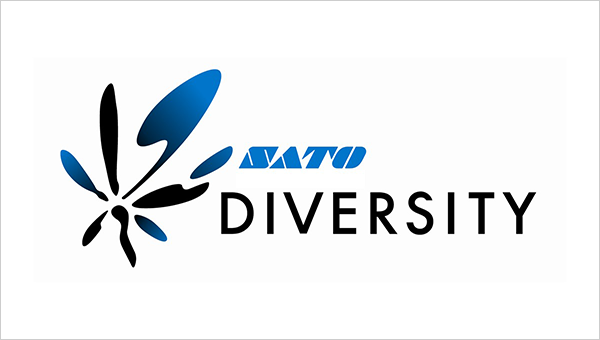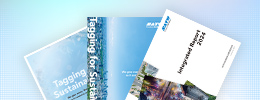SATO Group Declaration of Diversity
SATO Group is committed to providing a working environment where all employees, regardless of race, ethnicity, gender, nationality, culture, religion, educational background, disability or age are able to fully engage in open dialogue and active participation while recognizing and respecting each other's unique attributes.
The implementation of innovative programs designed to create a corporate culture rich in diversity will provide a work environment that embraces the generation of new ideas.
In line with our corporate spirit of "Ceaseless Creativity", we will continue to make daily efforts to improve the awareness of diversity within workplace, making it a pillar of our business strategy.
Our goal is to foster and promote diversity by leveraging each employee's unique abilities and giving all employees the opportunity to grow and excel. This approach is key to delivering the best possible solutions to meet the diverse needs of our global customers.
Diversity opens the door to productivity, competitiveness and sustainable growth. (Created December 9, 2011)

Framework
At SATO, we aim to build a workplace for diverse employees to work together toward our common goal of contributing to a better and more sustainable world with Ceaseless Creativity. We promote diversity through three pillars as follows.
First, through our HR Development Committee, which was established in FY 2022 under the board of directors' Nomination Advisory Committee (now merged with the Remuneration Advisory Committee). This committee meets every month and helps our executive team review and make decisions on how we manage human capital, for example, in terms of training talent for key roles and ensuring their diversity. Its scope of work also includes conducting surveys on the company's current diversity situation and discussing various KPIs. An executive officer on the committee set up a diversity subcommittee in FY 2023, which took ownership of running the following activities with speed in FY 2024.
- Establishing a team dedicated to promoting diversity
- Setting targets for female employment ratio (based on the Japanese government's targets) and putting plans into action
- Involving more women in the company's decision-making processes
- Organizing the SATO Women's Forum (Jan 2023 to Mar 2025: Two sessions held, each with about 50 participants)
- Holding discussions with non-Japanese employees and acting on their ideas
- Getting executive officers to post diversity-related content on our internal social networking site
Second, through employee-led diversity activities initiated by individual offices/departments in Japan. Each office/department identifies its diversity issues and takes actions to address them autonomously, with the help of a central steering committee.
Third, through DE&I initiatives that are based on our HR strategic objectives. We have a dedicated team (newly established in FY 2024) that works on projects with people with disabilities and supports minority groups, going beyond empowering women to expand recruitment and job opportunities and create an inclusive workplace environment for all. We also work with other companies and most recently participated in the 2024 DE&I program developed by Mitutoyo Corporation, bringing our employees together to learn, discuss and address the various dimensions of diversity.
By integrating these three pillars, we hope to achieve diversity and inclusion so that we can bring out the best in every employee and build a stronger SATO together.
When our President and Group CEO, Hiroyuki Konuma, took office in 2023, he took part in the Japanese government's call to action on male business leaders to create “A Society in Which Women Shine.” He will continue networking with other male leaders across various industries to advance gender equality and women empowerment in SATO.
Efforts to diversify key employees
The diverse strengths and capabilities of our employees are what make us competitive as a business. We actively recruit mid-career and non-Japanese professionals, with the former constituting more than 60 percent of our workforce in Japan. We work to build a diverse talent pool, hoping to better combine various specializations to broaden our business horizons and create new businesses. To expand the company's talent pipeline, we have also set diversity goals, which include increasing the number of female managers, as part of our efforts to diversify employees in key positions.
Diversity goals (Japan)
(1) Increase female managers
In Japan, about 25 percent of our employees and 8.5 percent of our managers are women. Although the ratio of female managers has already surpassed the 8.4 percent target we set for FY 2025, we aim to set department-level targets and continue raising both ratios, particularly the latter to over 10 percent by FY 2030.
You can scroll through this table.
| FY 2024 actuals | FY 2025 targets | FY 2030 targets | |
|---|---|---|---|
| Japan | 8.5% | 8.4% | 10.0% |
SATO Group: Number of employees
You can scroll through this table.
| FY 2021 | FY 2022 | FY 2023 | FY 2024 | |||||||||
|---|---|---|---|---|---|---|---|---|---|---|---|---|
| Men | Women | Total | Men | Women | Total | Men | Women | Total | Men | Women | Total | |
| Japan | 1,522 | 469 | 1,991 | 1,522 | 467 | 1,989 | 1,559 | 470 | 2,029 | 1,550 | 512 | 2,062 |
| Overseas | 2,072 | 1,593 | 3,665 | 2,087 | 1,561 | 3,648 | 2,146 | 1,569 | 3,715 | 2,286 | 1,638 | 3,924 |
| Overall | 3,594 | 2,062 | 5,656 | 3,609 | 2,028 | 5,637 | 3,705 | 2,039 | 5,744 | 3,836 | 2,150 | 5,986 |
SATO Group: Gender distribution of managers
You can scroll through this table.
| FY 2021 | FY 2022 | FY 2023 | FY 2024 | |||||
|---|---|---|---|---|---|---|---|---|
| Men | Women | Men | Women | Men | Women | Men | Women | |
| Japan | 92.0% | 8.0% | 92.7% | 7.3% | 92.1% | 7.9% | 91.5% | 8.5% |
| Overseas | 70.9% | 29.1% | 70.8% | 29.2% | 71.1% | 28.9% | 71.0% | 29.0% |
(2) Increase uptake of paternity leave
We are driving workstyle innovation by promoting company-wide telework and flextime, as well as flexible arrangements for employees with childcare commitments. In FY 2024, the utilization rates of paternity leave and childcare leave by eligible male employees (who had children born in the same year) both improved significantly year on year to 83.3 percent and 162.5 percent respectively. To help new mothers stay in the workforce, we encourage more male employees to take time off, ultimately raising paternity leave rate to our target of over 85 percent in FY 2030.
You can scroll through this table.
| Paternity and childcare-related leave rate | Paternity leave rate | Childcare-related leave rate | |
|---|---|---|---|
| Japan | 191.7% | 83.3% | 162.5% |
*Figures calculated based on the provisions of the Act on the Welfare of Workers Who Take Childcare Leave, Family Care Leave, etc. (Act No. 76 of 1991) and Article 71-6 of the Enforcement Regulations of the Act on the Welfare of Workers Who Take Childcare Leave, Family Care Leave, etc. (Ministry of Labour Ordinance No. 25 of 1991), which stipulates how to calculate the rate of employees taking childcare or family care leave.
(3) Reduce gender wage gap
We are committed to providing a gender-inclusive workplace with systems that pay and appraise male and female employees equally based on their work. However, due to the relatively smaller representation of women in leadership positions, the gender wage gap for our full-time employees stands at 72.1 percent in FY 2024. We are seeing success in retaining female employees to keep them longer with the company and will continue efforts to promote women's empowerment to build a more diverse and conducive workplace.
You can scroll through this table.
| Full-time employees | Part-time, contract employees | All employees | |
|---|---|---|---|
| Japan | 72.1% | 76.1% | 66.0% |
*Male and female employees with the same job and rank are paid equally. The gap between median male and female wages is influenced by differences in job level/type and years of service.
Our diversity initiatives in Japan
(1) Support the career advancement of female employees
- Conduct surveys on the career aspirations of female non-managerial employees and review survey results within the HR Development Committee to follow up with the necessary actions.
Set department-level targets (for improving gender balance and promoting women into more senior roles). - Have the different functional headquarters organize their own activities (such as talks and career development or pre-management trainings) to inspire and propel female employees toward success.
- Establish an interest group for driving women empowerment.
(2) Increase the motivation of older employees
- Since April 2007
- Raise the retirement age from 60 to 65 before this was made a statutory requirement.
- Since April 2009
- Remove the age limit for managerial positions, which was previously set at 56 years old. Older employees continue to be eligible for promotions, although with some salary adjustments.
- Since April 2011
- Introduce a Platinum Employment program for flexible retirement that lets employees aged 65 or above continue their careers in specialist roles on yearly contracts, subject to mutual agreement.
You can scroll through this table.
| FY 2021 | FY 2022 | FY 2023 | FY 2024 | |
|---|---|---|---|---|
| Retiring employees (aged 65) | 8 | 13 | 9 | 16 |
| Retiring employees who are reemployed | 2 | 8 | 8 | 11 |
| Reemployment ratio | 25% | 62% | 89% | 69% |
(3) Further empowerment of women
- Support female employees before and after giving birth with incentive and leave benefits such as baby bonus, post-natal paternity leave and self-care leave.
- Go beyond the statutory requirements by granting childcare support incentives and offering reduced hours to returning mothers for longer durations.
- Encourage active utilization of paternity leave and other childcare benefits.
- Provide online seminars on different health care topics (such as andropause and wellness of working women) to enhance employee health awareness and productivity and promote mutual understanding and diversity.
(4) Innovate workstyles and create a more engaging workplace for all
- Conduct surveys to regularly assess workplace engagement levels and take actions for improvement based on survey results.
- Introduce programs for internal recruitment, job transfer and global internship.
- Implement hybrid working arrangements that balance remote and in-office work.
Related data
New hire retention
You can scroll through this table.
| Year joined | |||||
|---|---|---|---|---|---|
| FY 2019 | FY 2020 | FY 2021 | FY 2022 | ||
| New graduate hires | Three-year retention rate | 90.5% | 93.1% | 81.8% | 78.1% |
| Headcount at end of three years | 19 | 27 | 18 | 25 | |
| Starting headcount | 21 | 29 | 22 | 32 | |
| Mid-career hires | Three-year retention rate | 81.5% | 88.9% | 83.3% | 88.9% |
| Headcount at end of three years | 75 | 40 | 40 | 40 | |
| Starting headcount | 92 | 45 | 48 | 45 | |
Employee tenure
You can scroll through this table.
| FY 2021 | FY 2022 | FY 2023 | FY 2024 | |
|---|---|---|---|---|
| Average years of service | 15.9 | 16.2 | 16.6 | 16.3 |
Disability inclusion
You can scroll through this table.
| FY 2021 | FY 2022 | FY 2023 | FY 2024 | |
|---|---|---|---|---|
| Ratio of employees with disabilities | 2.35% | 2.20% | 2.20% | 2.44% |
| Average monthly headcount | 51 | 47.7 | 42 | 44 |
Uptake of leave and flexible work options
You can scroll through this table.
| FY 2021 | FY 2022 | FY 2023 | FY 2024 | |
|---|---|---|---|---|
| Long-term caregiving leave | - | - | 1 | - |
| Short-term caregiving leave | 16 | 14 | 21 | 27 |
| Work support leave (system for employees to accumulate and use expired annual leave for medical or caregiving purposes) | 7 | 13 | 10 | 27 |
| Parental leave* | 22 | 29 | 33 | 23 |
| (-) | (8) | (17) | (13) | |
| Employees eligible for childcare leave* | 60 | 60 | 50 | 34 |
| (45) | (41) | (34) | (24) | |
| Maternity leave utilization rate | 100% | 100% | 100% | 100% |
| Paternity leave utilization rate | - | 19.5% | 50.0% | 54.2% |
| Employees back to work after maternity/paternity leave | 100% | 100% | 100% | 100% |
| Extended childcare leave | 61 | 80 | 86 | 100 |
| Reduced working hours | 75 | 82 | 92 | 93 |
| Annual leave utilization rate | 59.5% | 64.7% | 69.4% | 68.2% |
| Average annual leave days taken | 11.2 | 12.3 | 12.9 | 14.1 |
*Figures for male employees are indicated in parentheses.








